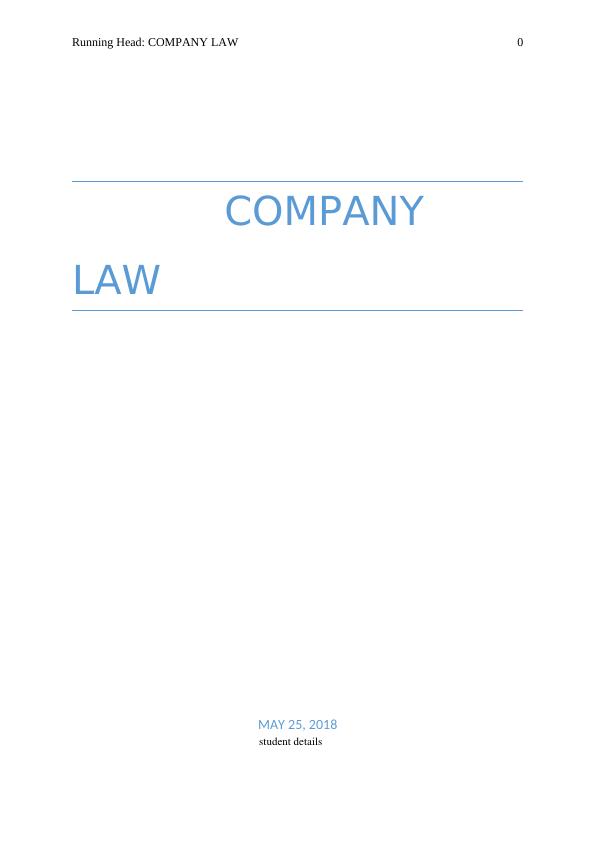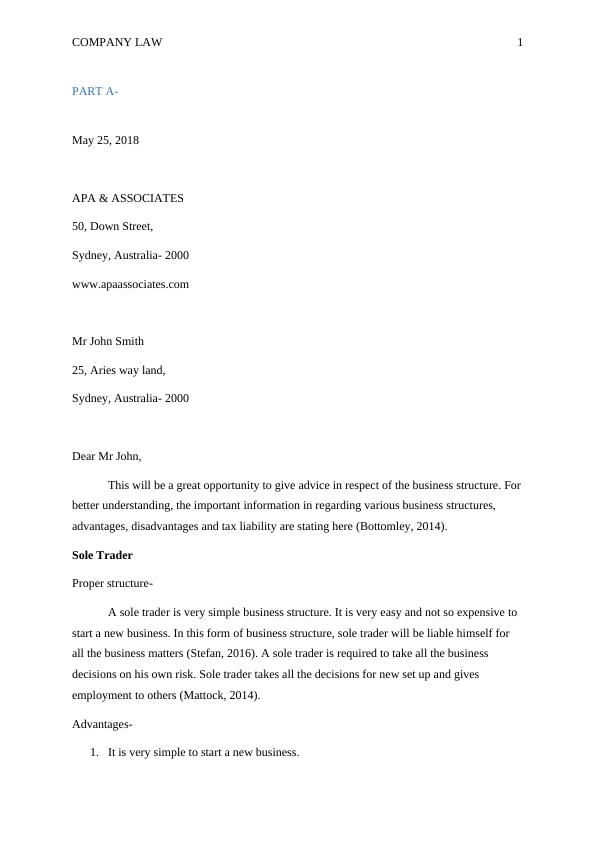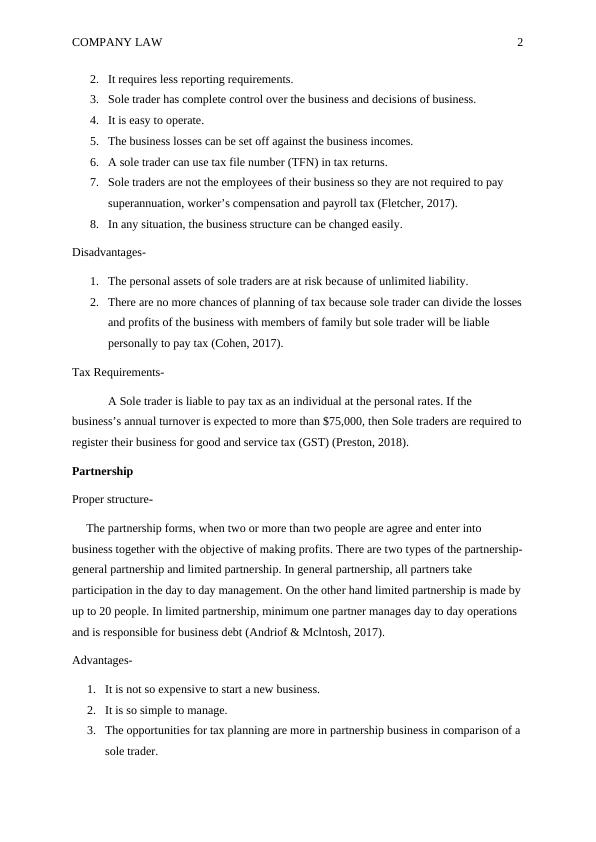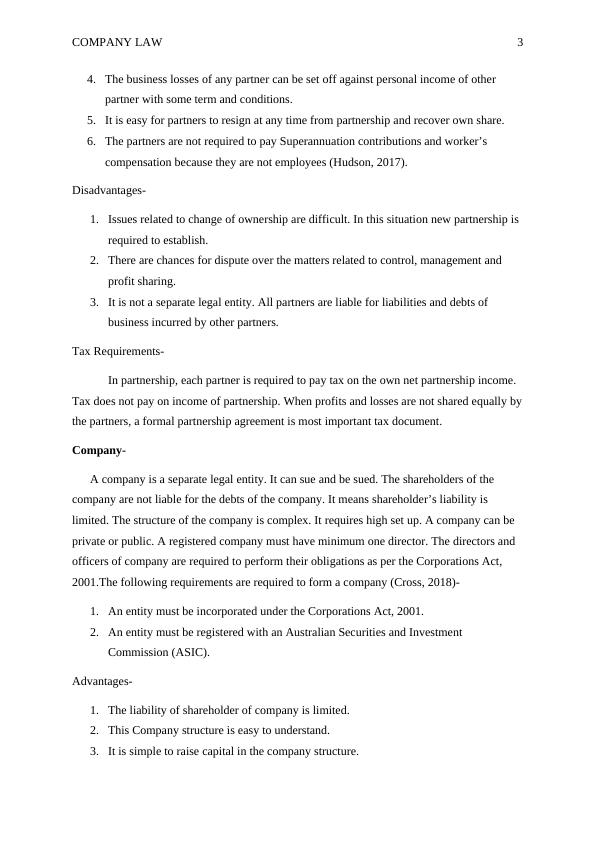Understanding Different Business Structures: Sole Trader, Partnership, Company, Trust, and Joint Venture
Added on 2023-06-11
14 Pages3053 Words133 Views
Running Head: COMPANY LAW 0
COMPANY
LAW
MAY 25, 2018
COMPANY
LAW
MAY 25, 2018

COMPANY LAW 1
PART A-
May 25, 2018
APA & ASSOCIATES
50, Down Street,
Sydney, Australia- 2000
www.apaassociates.com
Mr John Smith
25, Aries way land,
Sydney, Australia- 2000
Dear Mr John,
This will be a great opportunity to give advice in respect of the business structure. For
better understanding, the important information in regarding various business structures,
advantages, disadvantages and tax liability are stating here (Bottomley, 2014).
Sole Trader
Proper structure-
A sole trader is very simple business structure. It is very easy and not so expensive to
start a new business. In this form of business structure, sole trader will be liable himself for
all the business matters (Stefan, 2016). A sole trader is required to take all the business
decisions on his own risk. Sole trader takes all the decisions for new set up and gives
employment to others (Mattock, 2014).
Advantages-
1. It is very simple to start a new business.
PART A-
May 25, 2018
APA & ASSOCIATES
50, Down Street,
Sydney, Australia- 2000
www.apaassociates.com
Mr John Smith
25, Aries way land,
Sydney, Australia- 2000
Dear Mr John,
This will be a great opportunity to give advice in respect of the business structure. For
better understanding, the important information in regarding various business structures,
advantages, disadvantages and tax liability are stating here (Bottomley, 2014).
Sole Trader
Proper structure-
A sole trader is very simple business structure. It is very easy and not so expensive to
start a new business. In this form of business structure, sole trader will be liable himself for
all the business matters (Stefan, 2016). A sole trader is required to take all the business
decisions on his own risk. Sole trader takes all the decisions for new set up and gives
employment to others (Mattock, 2014).
Advantages-
1. It is very simple to start a new business.

COMPANY LAW 2
2. It requires less reporting requirements.
3. Sole trader has complete control over the business and decisions of business.
4. It is easy to operate.
5. The business losses can be set off against the business incomes.
6. A sole trader can use tax file number (TFN) in tax returns.
7. Sole traders are not the employees of their business so they are not required to pay
superannuation, worker’s compensation and payroll tax (Fletcher, 2017).
8. In any situation, the business structure can be changed easily.
Disadvantages-
1. The personal assets of sole traders are at risk because of unlimited liability.
2. There are no more chances of planning of tax because sole trader can divide the losses
and profits of the business with members of family but sole trader will be liable
personally to pay tax (Cohen, 2017).
Tax Requirements-
A Sole trader is liable to pay tax as an individual at the personal rates. If the
business’s annual turnover is expected to more than $75,000, then Sole traders are required to
register their business for good and service tax (GST) (Preston, 2018).
Partnership
Proper structure-
The partnership forms, when two or more than two people are agree and enter into
business together with the objective of making profits. There are two types of the partnership-
general partnership and limited partnership. In general partnership, all partners take
participation in the day to day management. On the other hand limited partnership is made by
up to 20 people. In limited partnership, minimum one partner manages day to day operations
and is responsible for business debt (Andriof & Mclntosh, 2017).
Advantages-
1. It is not so expensive to start a new business.
2. It is so simple to manage.
3. The opportunities for tax planning are more in partnership business in comparison of a
sole trader.
2. It requires less reporting requirements.
3. Sole trader has complete control over the business and decisions of business.
4. It is easy to operate.
5. The business losses can be set off against the business incomes.
6. A sole trader can use tax file number (TFN) in tax returns.
7. Sole traders are not the employees of their business so they are not required to pay
superannuation, worker’s compensation and payroll tax (Fletcher, 2017).
8. In any situation, the business structure can be changed easily.
Disadvantages-
1. The personal assets of sole traders are at risk because of unlimited liability.
2. There are no more chances of planning of tax because sole trader can divide the losses
and profits of the business with members of family but sole trader will be liable
personally to pay tax (Cohen, 2017).
Tax Requirements-
A Sole trader is liable to pay tax as an individual at the personal rates. If the
business’s annual turnover is expected to more than $75,000, then Sole traders are required to
register their business for good and service tax (GST) (Preston, 2018).
Partnership
Proper structure-
The partnership forms, when two or more than two people are agree and enter into
business together with the objective of making profits. There are two types of the partnership-
general partnership and limited partnership. In general partnership, all partners take
participation in the day to day management. On the other hand limited partnership is made by
up to 20 people. In limited partnership, minimum one partner manages day to day operations
and is responsible for business debt (Andriof & Mclntosh, 2017).
Advantages-
1. It is not so expensive to start a new business.
2. It is so simple to manage.
3. The opportunities for tax planning are more in partnership business in comparison of a
sole trader.

COMPANY LAW 3
4. The business losses of any partner can be set off against personal income of other
partner with some term and conditions.
5. It is easy for partners to resign at any time from partnership and recover own share.
6. The partners are not required to pay Superannuation contributions and worker’s
compensation because they are not employees (Hudson, 2017).
Disadvantages-
1. Issues related to change of ownership are difficult. In this situation new partnership is
required to establish.
2. There are chances for dispute over the matters related to control, management and
profit sharing.
3. It is not a separate legal entity. All partners are liable for liabilities and debts of
business incurred by other partners.
Tax Requirements-
In partnership, each partner is required to pay tax on the own net partnership income.
Tax does not pay on income of partnership. When profits and losses are not shared equally by
the partners, a formal partnership agreement is most important tax document.
Company-
A company is a separate legal entity. It can sue and be sued. The shareholders of the
company are not liable for the debts of the company. It means shareholder’s liability is
limited. The structure of the company is complex. It requires high set up. A company can be
private or public. A registered company must have minimum one director. The directors and
officers of company are required to perform their obligations as per the Corporations Act,
2001.The following requirements are required to form a company (Cross, 2018)-
1. An entity must be incorporated under the Corporations Act, 2001.
2. An entity must be registered with an Australian Securities and Investment
Commission (ASIC).
Advantages-
1. The liability of shareholder of company is limited.
2. This Company structure is easy to understand.
3. It is simple to raise capital in the company structure.
4. The business losses of any partner can be set off against personal income of other
partner with some term and conditions.
5. It is easy for partners to resign at any time from partnership and recover own share.
6. The partners are not required to pay Superannuation contributions and worker’s
compensation because they are not employees (Hudson, 2017).
Disadvantages-
1. Issues related to change of ownership are difficult. In this situation new partnership is
required to establish.
2. There are chances for dispute over the matters related to control, management and
profit sharing.
3. It is not a separate legal entity. All partners are liable for liabilities and debts of
business incurred by other partners.
Tax Requirements-
In partnership, each partner is required to pay tax on the own net partnership income.
Tax does not pay on income of partnership. When profits and losses are not shared equally by
the partners, a formal partnership agreement is most important tax document.
Company-
A company is a separate legal entity. It can sue and be sued. The shareholders of the
company are not liable for the debts of the company. It means shareholder’s liability is
limited. The structure of the company is complex. It requires high set up. A company can be
private or public. A registered company must have minimum one director. The directors and
officers of company are required to perform their obligations as per the Corporations Act,
2001.The following requirements are required to form a company (Cross, 2018)-
1. An entity must be incorporated under the Corporations Act, 2001.
2. An entity must be registered with an Australian Securities and Investment
Commission (ASIC).
Advantages-
1. The liability of shareholder of company is limited.
2. This Company structure is easy to understand.
3. It is simple to raise capital in the company structure.

End of preview
Want to access all the pages? Upload your documents or become a member.
Related Documents
Business Structures Assignment PDFlg...
|8
|1974
|49
Law and applicability of law. Application to the business of David and Liamlg...
|11
|2669
|358
Different Business Structures in Australia: A Legal Advicelg...
|12
|3327
|109
Proprietary Company at the initial levellg...
|9
|1934
|21
Different Business Structures in Australia: Sole Trader, Partnership, Joint Venture, Trust, and Companylg...
|11
|2780
|308
Company Law: Business Structures, Liability, and Consumer Lawlg...
|11
|2342
|230
